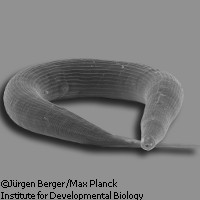Scientists decode genome of beetle-loving nematode
A transatlantic research project has decoded the genome of the Pristionchus pacificus nematode. The work, carried out by the scientists at the Max Planck Institute for Developmental Biology in Germany along with their US counterparts at the National Human Genome Research Institute in St. Louis, offers the world an inside look at the evolution of parasitism, especially by raising awareness of the complex interactions between the host and parasite. Their findings were recently published in the journal Nature Genetics. Led by Professor Ralf J. Sommer, a researcher at the Max Planck Campus in Tübingen, Germany, the research team discovered that the genome of the nematodes, which are unsegmented worms with elongated, rounded bodies pointed at both ends, has an extensive number of genes, with some having unexpected functions. The researchers said several genes are instrumental in breaking down substances needed by an organism to survive in foreign habitats or even substances that are detrimental to them. A case in point is the Pristionchus pacificus, which set its sights on beetles for shelter and transport. Of particular interest is the fact that the nematode also feeds on the fungi and bacteria found on the carcass of the beetle once it has died. Nematodes rank first in terms of group size in the animal kingdom, the researchers said. More than 1 million different species of these worms exist on the planet, and some are parasites and others are pathogens to humans, animals and plants, they added. Past studies have found that seven forms of parasitism exist within the nematode group. A popular subject of study is the Caenorhabditis elegans, whose genome was decoded a decade ago. This latest research brings to the surface the genome of another species of nematode: the model organism Pristionchus pacificus. Based on the findings, Pristionchus pacificus make their home with various beetles (e.g. dung, May and potato) so as to secure food for themselves once the beetles die, as well as shelter. The researchers said the habitat of the Pristionchus pacificus changes when it turns to the beetle for shelter. For example, beetles contain toxic substances that force the nematodes to protect themselves for their security. Their method of coping, the researchers found, is due to the genome of the Pristionchus pacificus. This genome, which consists of some 170 megabases, contains over 23,500 protein-coding genes. This number is much larger than the 12,000 protein-coding genes found in the human parasite Brugia malayi, for instance. 'The increase in Pristionchus is partly attributable to gene duplications,' Professor Sommer said. 'These include a number of genes that could be helpful for breaking down harmful substances and for survival in the complex beetle ecosystem.' Professor Sommer also touched on the importance of the use of sequence data. 'We can test how Pristionchus has adapted to specific habitat,' he said. 'And this will undoubtedly give us new insight into the evolution of parasitism.'
Countries
Germany, United States

